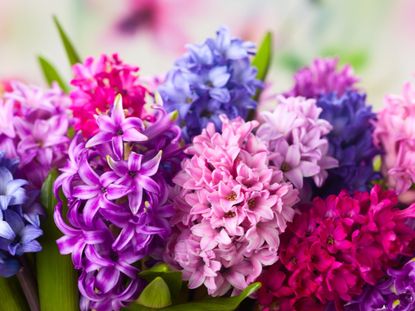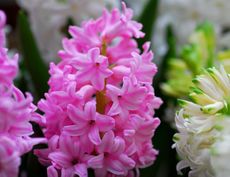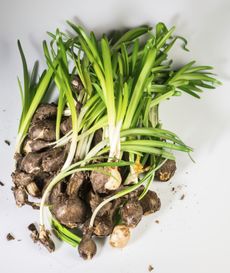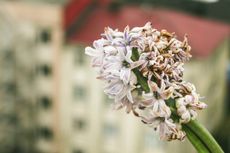Hyacinth Flower Bulbs: Planting And Care Of Hyacinths In The Garden


One of the earliest spring bulbs is the hyacinth. They usually appear after crocus but before tulips and have old-fashioned charm combined with a sweet, subtle scent. Hyacinth flower bulbs need to be planted in fall so the bulb experiences winter temperatures and breaks dormancy. Continue reading for some tips on how to plant hyacinth flowers in the garden so you can enjoy some early spring color.
Planting Hyacinth Bulbs
Hyacinths in the garden are suitable for a wide range of USDA zones, 3 through 9. They are thought to be native to the eastern Mediterranean region and need well-draining soil and winter's chill to thrive.
Their signature fragrance has been used in French perfume and their appearance is a part of the Persian New Year celebrations. In the home garden, they are just plain lovely and a signal that spring has arrived and colorful flower displays are just getting started.
One of the most common problems with any bulb is waterlogged soil. If soil doesn't drain well, the bulb sits in water and is prey to rot. Prior to planting hyacinth bulbs, perform a drainage test by digging a trench, filling it with water, and watching how long it takes to drain.
If water is still sitting in the trench a half hour later, you will need to amend the soil by mixing in leaf litter or other organic amendments, compost, or even a bit of sand or pebbles. Tilling, drainage, and organic matter are the most important components for hyacinth flower bulbs. In heavy clay soils, consider planting in a raised bed to encourage draining.
How to Plant Hyacinth Flowers
In fall, around September to October, plant your bulbs. Choose fat, large bulbs with no signs of disease and decay. Plant the bulbs at least three to four times as deep as they are tall. Install them with the pointed side up.
The flowers perform best in full sun but will still produce blooms in partial shade. They should at least experience six hours per day of sunlight.
Gardening tips, videos, info and more delivered right to your inbox!
Sign up for the Gardening Know How newsletter today and receive a free download of our most popular eBook "How to Grow Delicious Tomatoes."
If your soil has low nutrients, mix in a 5-5-10 slow release plant food. Hyacinths in the garden usually need no care after planting until blooming because nature will perform the chilling requirements necessary to force flowering once temperatures warm.
Care for Hyacinths Outdoors
In good soil, these sweet flowers need little care. Water after installation if no precipitation is expected.
Feed bulbs every spring with bulb food. Scratch it into the soil around the bulbs and water in.
Once flowers are finished blooming, cut off the flower stalk but leave the foliage. They will produce and store energy for the following year's growth. Once leaves are yellow and limp, you can usually just pull them easily from the soil if you wish.
If winter temperatures do not get below 60 degrees F. (16 C.), dig up the bulbs and store them in a refrigerator for eight weeks prior to replanting.
Slugs are occasional pests, but deer and rabbits avoid this plant due to its oxalic acid content.

Bonnie Grant is a professional landscaper with a Certification in Urban Gardening. She has been gardening and writing for 15 years. A former professional chef, she has a passion for edible landscaping.
-
 Urban Composting Guide: How To Compost In The Middle Of The City
Urban Composting Guide: How To Compost In The Middle Of The CityUrban composting does not have to be daunting. You can compost in the city, and maybe even try some urban worm composting!
By Mary Ellen Ellis
-
 Shrub Diseases And Pests To Watch Out For
Shrub Diseases And Pests To Watch Out ForShrub diseases and pests can be challenging. Learn how to recognize and eradicate them before they can present a danger to your plants.
By Susan Albert
-
 Hyacinth Bulb Itch – What To Do For Hyacinth Skin Allergy
Hyacinth Bulb Itch – What To Do For Hyacinth Skin AllergyHyacinth is a popular fall planted bulb for cheerful, fragrant spring blooms. These flowers help to drive away winter glooms. Unfortunately, hyacinth irritation can be an issue. Learn more about this skin problem, referred to as hyacinth bulb itch, in the following article.
By Mary Ellen Ellis
-
 Growing Amethyst Hyacinths: Information On Amethyst Hyacinth Plants
Growing Amethyst Hyacinths: Information On Amethyst Hyacinth PlantsGrowing Amethyst hyacinths (Hyacinthus orientalis ‘Amethyst’) couldn’t be much easier and, once planted, each bulb produces one spiky, sweet-smelling, pinkish-violet bloom every spring, along with seven or eight big, shiny leaves. Learn more in this article.
By Mary H. Dyer
-
 Hyacinth Seed Propagation – How To Grow Hyacinths From Seed
Hyacinth Seed Propagation – How To Grow Hyacinths From SeedAs hyacinth flowers fade and small green seed pods begin to form in their place, you may wonder, can you propagate hyacinth seeds? Click this article to learn about saving hyacinth seed and hyacinth seed propagation.
By Darcy Larum
-
 Curing Hyacinths: When To Dig Up Hyacinth Bulbs For Storing
Curing Hyacinths: When To Dig Up Hyacinth Bulbs For StoringIt's important not to dig up your hyacinth bulbs at the wrong time, or else your bulbs may not have enough energy to sprout. Learn about hyacinth bulb curing and storing hyacinth bulbs in the article that follows. Click here for more info.
By Liz Baessler
-
 Propagating Hyacinth Offsets – How To Propagate Bulbs Of Hyacinth
Propagating Hyacinth Offsets – How To Propagate Bulbs Of HyacinthAlthough most gardeners find it easier and faster to purchase hyacinth bulbs, hyacinth propagation by seeds or offset bulbs is easier than you may think. Want to learn more about propagating and growing hyacinth bulbs? Click here.
By Mary H. Dyer
-
 Container Grown Hyacinths: How To Plant Hyacinth Bulbs In Pots
Container Grown Hyacinths: How To Plant Hyacinth Bulbs In PotsHyacinths are famous for their pleasant fragrance. They also grow very well in pots, perfuming a patio, a walkway, or a room in your house. Learn how to plant hyacinth bulbs in pots in this article.
By Liz Baessler
-
 Indoor Hyacinth Care: Caring For Hyacinth Houseplants Post Flowering
Indoor Hyacinth Care: Caring For Hyacinth Houseplants Post FloweringBecause of their attractive flowers and delicious smell, potted hyacinths are a popular gift. Once they?re done blooming, though, don?t rush to throw them away. With a little care, you can keep your indoor hyacinth after blooming. This article will help.
By Liz Baessler
-
 My Hyacinth Is Turning Brown – Caring For Browning Hyacinth Plants
My Hyacinth Is Turning Brown – Caring For Browning Hyacinth PlantsHyacinths make great indoor or outdoor plants and are harbingers of spring, but when they start turning brown, these cheery faces are suddenly a reason for panic. Find out if your hyacinth has a real problem or if it's just going through its normal lifecycle in this article.
By Kristi Waterworth